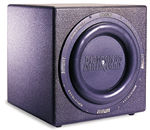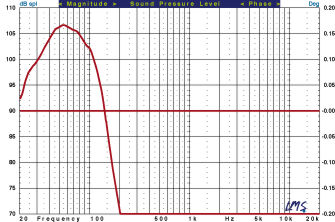Written By Kevin Hunt - Sound & Vision
December 29, 2001
“Meaty, beaty, little, and bouncy.”
The Earthquake SuperNova could be the world’s most dangerous end table. No amount of Krazy Glue will repair the heartbreak of the unwary soul who dares place the family-heirloom Tiffany lamp or Waterford vase on this compact subwoofer. This is not a New Age sub disguised as a fine piece of furniture, a veneered life-style block that magically comes to life when The Matrix flashes across the television screen. The SuperNova MKIV-12P is a big-lipped powerhouse of a subwoofer that pretends to be nothing other than that. When this 15-inch cube busts out, its fully exposed drivers flapping in the breeze, the results are nearly seismic: more than 100 decibels at 20 hertz, the home theater nether world of deep bass. Vibrations caused by the SuperNova can, no exaggeration, knock dishes from shelves and lightly secured wall hangings right off their hooks. Forget about using it in an apartment building. In a retirement community, it would be judged a menace to society. You’ve already been warned about the lamp or vase.
that magically comes to life when The Matrix flashes across the television screen. The SuperNova MKIV-12P is a big-lipped powerhouse of a subwoofer that pretends to be nothing other than that. When this 15-inch cube busts out, its fully exposed drivers flapping in the breeze, the results are nearly seismic: more than 100 decibels at 20 hertz, the home theater nether world of deep bass. Vibrations caused by the SuperNova can, no exaggeration, knock dishes from shelves and lightly secured wall hangings right off their hooks. Forget about using it in an apartment building. In a retirement community, it would be judged a menace to society. You’ve already been warned about the lamp or vase.
Even as the Sunfire-inspired bass race shifts from bigger and louder subwoofers to smaller and even-louder ones, Earthquake subs remain among the loudest and, dollar-per-decibel, among the top performers. Earthquake says the SuperNova MKIV-12P ($1,697) plays even louder and, more significantly, faster and more coherently with music than its predecessors.
Technologically speaking, the SuperNova MKIV-12P isn’t too different from Earthquake’s MKII edition, but it has been reconfigured in two notable areas. The two 12-inch drivers—an active, cast-basket Magma driver and a passive SLAPS radiator—are now mounted across from, rather than adjacent to, each other. Earthquake says that this push-pull setup in a sixth-order enclosure gives the SuperNova greater output and better control. Indeed, the variable bass-boost feature found on previous models, which adds up to 6 dB at 25 Hz, has been deemed redundant and thus eliminated.
The control panel, which doubles as a chassis for the cool-running, Sunfire-esque 580-watt class D amplifier, has been shifted from the bottom panel to a side panel. Why was it ever on the bottom panel? Well, Earthquake thought that this location would make the control panel childproof, but it turned out to be adultproof, too. Although there’s no obvious vent, the sub’s passive radiator is considered a vented design, which typically plays louder than a sealed-enclosure design but rates higher in phase shift and group delay. Earthquake’s Joseph Sahyoun, who designed the SuperNova, sought the benefits of both designs by tuning the sub to shift those distortions to an inaudible frequency. In actuality, this requires a port too big for the enclosure, so Sahyoun developed SLAPS (Symmetrically Loaded Audio Passive System), which allows for massive air movement. Earthquake says the passive radiator has a linear excursion rate of up to 4 inches. To withstand that kind of force, the big-lipped SLAPS is constructed of 1-inch-thick, thermally pressed polyether foam. The lips that rim the driver start out even thicker, pressed from 1.5-inch foam.
The passive radiator has no voice coil or magnet assembly and is weighted with a steel cylinder (the bolt protrudes from the driver) to about 17 Hz, about an octave below the resonance of a sealed sub of this size. If you want to see some major-league flapping, Sahyoun suggests sending a 15-Hz sine wave through the SuperNova. (Sorry, since most subs don’t go that low, I couldn’t find a test CD that even bothered to reach below 20 Hz.) Above that tuned frequency, the SuperNova has been designed to achieve a phase response similar to that of a sealed-design sub.
and is weighted with a steel cylinder (the bolt protrudes from the driver) to about 17 Hz, about an octave below the resonance of a sealed sub of this size. If you want to see some major-league flapping, Sahyoun suggests sending a 15-Hz sine wave through the SuperNova. (Sorry, since most subs don’t go that low, I couldn’t find a test CD that even bothered to reach below 20 Hz.) Above that tuned frequency, the SuperNova has been designed to achieve a phase response similar to that of a sealed-design sub.
The Magma driver features a 3-inch (diameter) voice coil with a 1.85-inch winding length, a 7-inch (diameter) epoxy-coated super spider, and double-stacked, high-gauss magnets with a combined height of 1.5 inches.
The MKIV-12P’s Millennium class D amplifier has a patented Optical Distortion Limiting circuit, an anticlipping feature that converts analog signals to light and couples them with the driver stage. Bottom line: It reduces distortion at high volume levels. The SuperNova has speaker-level inputs and outputs, but Earthquake emphatically recommends using line-level inputs with an appropriate high-quality cable and Y adapter. (A line-level 100-Hz high-pass output is also available.) The control panel also contains the volume control, a 24-dB/octave low-pass filter continuously variable from 50 to 150 Hz, a phase switch (0 and 180 degrees), an auto/off switch, an always-on red-LED power indicator, and a detachable IEC power cable. You can also control the volume, somewhat noisily, via the remote, which activates a tiny optical sensor that’s attached to the SuperNova by a thin cord.
The main body of the sub—a 15-inch cube with a heavy-duty polyurethane hard-shell finish—weighs 69 pounds. (The black-ash model, with a Plexiglas top cover, weighs 5 pounds more.) The sub’s walls are 0.75-inch MDF, reinforced at the joints by 1-inch pine blocks. At Sahyoun’s urging, I set up the SuperNova by ear instead of by test disc. He says the best crossover setting is usually between the 1 o’clock and 2 o’clock positions (about 100 to 110 Hz) and that the volume should never exceed 12 o’clock. The latter is particularly sound advice. This sub plays loud enough (over 100 dB) to damage your hearing. Remember, a jet airplane taking off generates 125 dB of sound.

The SuperNova might display some of the behavioral characteristics of a sealed design, but it is harder to set up. To lock in the sound, you’ll have to move it a little this way and a little that way. Before you start, decide if you want the full bottom-end benefit for home theater or a slightly less-extended low end with a more-agile response that’s suited to music. To get the all-out sonic blast, the passive radiator should face the nearest side wall and sit about 5 inches from it. Of course, if you place the SuperNova against the left wall, the control panel will stare out into your room. If you place the sub in a corner, with the passive radiator facing the intersection of the two walls, the SuperNova loses some slam but picks up speed, which is better for music.
I preferred the latter setup, but the movie setup is goose-bump material. The sonic impact was so overwhelming that I went back to home theater chestnuts like the train wreck in The Fugitive and the opening of GoldenEye. Just when you think you know a scene after seeing it 500 times . . .
This subwoofer took my home theater to new depths. Turn on a movie and watch the SLAPS-happy rubber fly. Va-va-voom. The “Time’s Up” alien attack in Independence Day blew me away, even with the undersized but crystalline picture from Zenith’s snazzy 15-inch ZLD15A1 LCD TV/
PC monitor. I knew the SuperNova was a different animal right away. Early in the break-in process, I left the remote control atop the sub. Within seconds, it was on the floor. The SuperNova is a mover and shaker, no question. Some owners of previous SuperNova editions were critical of their slow-as-the-IRS response with music. The SuperNova MKIV-12P might not be top-of-the-heap fast, but it’s hardly slow. I tried this sub with an assortment of speakers, including a Snell system fronted by a pair of QBx 25 Towers. I also gave it several tests with small speakers: the Heybrook Series 2000, the PSB Alpha-A/V, and finally the PSB Alpha B, an exciting new budget speaker so radically redesigned that PSB probably should have given it an altogether new designation. With its crossover frequency set at about 100 Hz, the SuperNova carried the smaller speakers’ load. At about $1,125 for five speakers, the new PSB Alpha B system and the SuperNova might seem unlikely partners, but it’s a knockout system for about $2,800.
When I played “I Thought About You,” Diana Krall’s offering to Ray Brown’s Some of My Best Friends Are . . . Singers, there were times when the SuperNova placed Brown’s bass lines in perfect context with the Alphas. It also passed a pop bass test, Steely Dan’s “What a Shame About Me” from the Dolby Digital mix of the Two Against Nature DVD-Audio. DTS Entertainment’s DVD-Audio edition of Steve Stevens’ Flamenco.A.Go.Go, a press handout at the Home Entertainment 2001 Show, is a peculiar Gipsy-Kings-meets-Spyro-Gyra effort, and the bass on the 5.1 mix of “Our Man in Istanbul” illustrated what a difference the SuperNova’s room position can make. In the movie setting, the sub plodded through “Istanbul.” The music setup brought some relief—specifically, a quicker, more-complementary bottom end.
It doesn’t have to be either/or with the SuperNova. The remote’s volume control allows you to rapidly adjust bass output. (The optical sensor, it should be noted, picks up the signal from other remotes, too. So, if you don’t place the sub out of the way, it will send out a slight thud each time you press any remote’s volume control.) You could also use separate crossover points for music and movies—one (the higher) at the SuperNova and the other at your receiver or processor.
Although its status in the bass race gets all the attention—the SuperNova is now smaller and louder!—Earthquake seems to have hit a nice blend of power and speed with the MKIV-12P. Unless you’re building a 1,500-seat amphitheater in your backyard, it’s hard to imagine that you’d want anything louder. In case you do, though, there’s the bigger and louder SuperNova MKIV-15P.

HT Labs Measures

This graph shows the quasi-anechoic close-miked response of the MKIV-12P subwoofer, normalized to the average level from 40 to 80 hertz, which indicates that the lower -3decibel point is at 37 Hz and the -6dB point is at 31 Hz. The upper -3dB point is at 91 Hz with the “X-Over Freq” control set to maximum.—AJ
